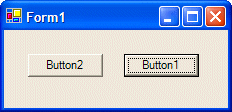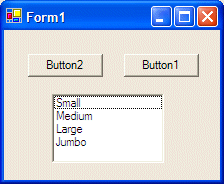
Methods of Managing Windows Controls
 |
Methods of Managing Windows Controls |
A method is a procedure created as a member of a class. Methods are used to access or manipulate the characteristics of an object or a variable. There are mainly two categories of methods you will use in your classes:
As you know from your study of the C# language, every class has a fundamental method called a default constructor. Every control of the .NET Framework is based on a class that has a default constructor and most of those classes have only one constructor: the default. The default constructor allows you to instantiate the class without necessarily initializing it. To use it, you must know the name of the control you want to use since each control bears the same name as its class. Here is an example: using System;
using System.Windows.Forms;
public class Exercise : System.Windows.Forms.Form
{
private Button btnReset;
public Exercise()
{
InitializeComponent();
}
#region Section Used to Initialize Controls
private void InitializeComponent()
{
btnReset = new Button();
}
#endregion
static void Main()
{
Application.Run(new Exercise());
}
}
If you are not planning to use a control straight from the .NET Framework, you can also create your own class that is derived from the class of the control, as we have mentioned in previous lessons. As mentioned in the previous lesson, after instantiating a control, it is available but the user cannot see. Each control that acts as a parent of another control has a property called Controls. This property, which is a ControlCollection type, is equipped with an Add() method. If you want to display the new control to the user, you should pass it to the Control.Controls.Add() method. Here is an example: using System;
using System.Windows.Forms;
public class Exercise : System.Windows.Forms.Form
{
private Button btnReset;
public Exercise()
{
InitializeComponent();
}
#region Section Used to Initialize Controls
private void InitializeComponent()
{
btnReset = new Button();
Controls.Add(btnReset);
}
#endregion
static void Main()
{
Application.Run(new Exercise());
}
}
This displays the control to the user. After using a control, it must be destroyed. In C++, this is traditionally done using the delete operator in the destructor of the parent of all controls, which could be a form. Another detail of Windows controls is that they use or consume computer resources during their lifetime. When the controls are not used anymore, such as when their application closes, these resources should be freed and given back to the operating system to make them available to other controls. This task can be performed using the Dispose() method to the Control class, which can then be overridden by its child controls. The syntax of the Control.Dispose() method is: protected override void Dispose(bool disposing); This method takes one argument, disposing, that indicates how the resources would be released. If this argument is passed with a false value, only the unmanaged resources would be released. If it is passed as true, then both managed and unmanaged resources would be released.
In the previous lesson, we saw that you can call the Visible property to hide a visible control or to display a hidden control. Besides the Visible property, you can also display a control using the Show() method. Its syntax is: Public Sub Show() When you use this method, if the control is visible, nothing would happen. If it were hidden, then it would be revealed. In the following example, a text box named textBox1 is asked to display: private void button1_Click(object sender, System.EventArgs e)
{
this.textBox1.Visible = false;
}
private void button2_Click(object sender, System.EventArgs e)
{
this.textBox1.Show();
}
The Show() method internally sets the Visible property to true. We also saw that, to hide a control, you can set its Visible property to False. In the same way, to hide a control, you call can the Control.Hide() method. Its syntax is: Public Sub Hide() In the following example, the visibility of a text box named textBox1 is toggled by the user clicks a button named button1: private void button1_Click(object sender, System.EventArgs e)
{
if( this.textBox1.Visible == true )
this.textBox1.Hide();
else
this.textBox1.Show();
}
Keep in mind that hiding a control does not close or destroy it.
Once a control is visible, the user can use it. Some controls allow the user only to read their text or view what they display. Some other controls allow the user to retrieve their value or to change it. To perform such operations, the user must first give focus to the control. The focus is a visual aspect that indicates that a control is ready to receive input from the user. Various controls have different ways of expressing that they have received focus. Button-based controls indicate that they have focus by drawing a dotted rectangle around their caption. In the following picture, the button on the right has focus:  A text-based control indicates that it has focus by displaying a blinking cursor. A list-based control indicates that it has focus when one of its items has a surrounding dotted rectangle:  To give focus to a control, the user can press a key such as Tab. To programmatically give focus to a control, call the Focus() method. Here is an example: private void button2_Click(object sender, System.EventArgs e)
{
this.textBox1.Focus();
}
In the previous lesson, we saw how you can position controls visually or manually. In some cases, you end up with one control positioned on top of another. Of course the first remedy that comes in mind would consist of moving one of the controls away from the other. This would also imply sometimes that you would have to enlarge and/or heighten the controls' container. There are situations that either you don't want to resize the parent or you can't: your only solution is to have one control on top of another. Fortunately, you can cope with this situation by specifying, when needed, what control at what time should be displayed to the user. When one control is positioned on top of another, they use a third axis whose origin, like that or the other axes, is on the top-left corner of the parent. This third axis, also considered the z-axis, is oriented so that it moves from the monitor towards the user. The operating system is in charge of positioning and drawing the objects on the screen. You as the programmer can direct the operating system as to what object should be on top and what object should be behind. To support these changes the Control class uses two methods that its appropriate children derive also. When a control A is positioned behind a control be, this causes control be either partially or completely hidden. If you want the control A to change its z-order and become on top of control B, you can call its BringToFront() method. The syntax of this method is: public void BringToFront(); On the other hand, if a control B is positioned on top of a control A, if you want control B to become positioned behind control A, you can call control B's SendToBack() method. Its syntax is: public void SendToBack(); After the controls have been positioned, at any time, when you access a control, if you want to know whether that control is the most top object, you can call its GetTopLevel() method. Its syntax is: proteced bool GetTopLevel();
The Windows controls available from the .NET Framework and that we will user throughout this site are fully functional. They are equipped with various methods ready to be used. Of course, no library can surely provide every single type of method that every programmer would use. For this reason, it will not be unusual that you need a method that is not available for a control you are using. In the same way, when you create a Windows Application that is based on a Form class, you will likely need a method that is not defined in the Form class. In this case, you can create your own and new method. A method is created like a normal procedure. If you want to add it to a form, you can open the Code Editor and write your procedure outside of any existing procedure. Here is an example: /// <summary>
/// The main entry point for the application.
/// </summary>
[STAThread]
static void Main()
{
Application.Run(new Form1());
}
double CalculateRectangleArea(Rectangle Recto)
{
return Recto.Width * Recto.Height;
}
}
}
In the same way, if you derive a class from one of the existing classes because you want to get a custom control from it, you can declare a new method as you see fit and use it appropriately. Probably the best way is to let the Code Editor insert the new method based on your specifications. To do that, in the Class View, first expand the name of the project. Then, right-click the name of the class where you want to add a new method, position the mouse on Add, and click Add Method. This would open the C# Method Wizard dialog box you can fill out and click Finish. After the method's body has been defined you
The Windows controls featured in the .NET Framework are highly varied and provide all the necessary regular functionality a normal application would need. They do this through various properties and their different methods. To enhance their functionality and speed up application development, Visual Basic offers a very extended library of functions to cover different issues including mathematics, finance, date, time, and commerce, etc. Because Visual Basic runs on Microsoft Windows, some functionality is available only as part of then operating system. This is done throughout a vast collection of functions and structures. Because these Win32 resources are not part of Visual Basic, if you want to use them, you must explicitly "load" them into your application |
|
|
|
||
| Previous | Copyright © 2004-2010 FunctionX, Inc. | Next |
|
|
||